Interviews
In Conversation with Christoph Grainger-Herr, CEO of IWC
Bruce McLaren wrote his name indelibly into the canon of automotive racing legend thanks to his unique skillset: he was a masterful car analyst, engineer and designer, as well as a talented racer. Similarly, in the world of luxury watchmaking Chris Grainger-Herr is unique in that he is the only man in the history of the industry to combine the roles of CEO and lead architect of the brand manufacture. His hobbies offer some clues as to how he balances these two important roles.
Grainger-Herr has a background in military ski touring and alpine trail running. And for someone that does decently either on foot or on bike on a flat road, there is nothing that fills me with greater dread than a sharp incline leading to higher elevation. I recall experiencing this for a seeming eternity when Grainger-Herr’s predecessor Georges Kern invited me on a 2000-kilometre bicycle race aptly named Tortour (a race that Grainger-Herr has now completed twice), to the extent that I was tempted to cycle off the side of the mountain. These sorts of challenges take discipline, perseverance and an extraordinary mental focus.
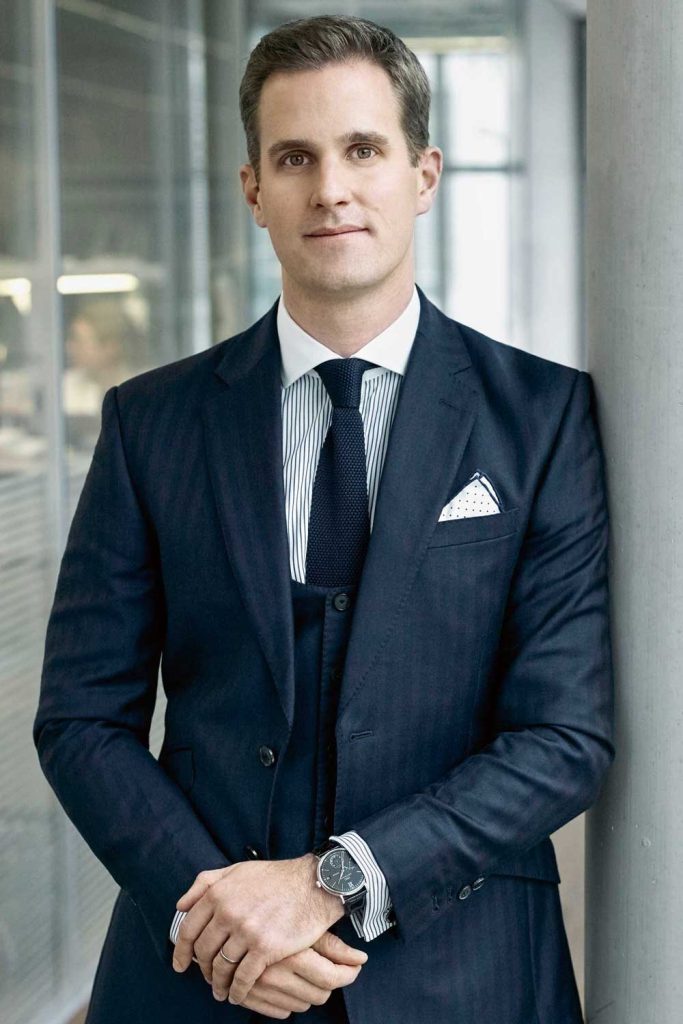
Christoph Grainger-Herr, IWC CEO
How does it feel to see the building you’ve designed open its doors?
It’s the biggest and most complex building I’ve designed as a free-standing structure, and the most important one to me by far. At the end of the day this is where it all happens: it is the home and epicentre of all our watchmaking. When I saw the 240 people who will occupy this building entering it for the very first time, I have to admit it was quite emotional.
Anybody creative can relate to this. An idea begins as a dream in your head and then one day, when it materialises, you can look back to a time when it was just a sketch. I’ve felt this way for many years at SIHH (Grainger-Herr also designs the booths there). It all begins with the question “Can I do this?” From there, you start all the planning and project management to make it happen. Then when it’s finished, other people might walk in and get the feeling that it has always been like this — but you know that it hasn’t. And even when it is finished there will still be more changes to come.
What was the most significant challenge in the design process?
All large-scale projects come with almost daily challenges, but as long as everyone involved is working towards the same end goal, you resolve them all. If you think about a manufacture like this, if you think about all the air-handling technology or the power generation and regeneration technology, the controlled dust environment, the hyperbaric environment you need to have in the assembling space, it would be an illusion to say you can plan and execute a building of that complexity without any technical headaches. But the important thing is we came out the opposite side, and the building and everything works the way it should.
How is this new manufacture game changing for IWC?
What’s most important for us is having massive flexibility in assembly now, thanks to our huge clean room. You have the problem in watch manufacturing where you are constantly trying to puzzle-fit together processes for certain special constraints. In a pre-existing structure you say, OK, I’ve got this space and I can fit 12 people there, so who should I put there? And this is really the wrong way around. What you want to say is, I’ve got to have this function, and then you build up and optimise the space around it. And now with 1,100 square meters and almost all open-plan with very few columns, we have such flexibility.
In fact, we’ve already reconfigured a few times since opening. We have the luxury to create the most intuitive and efficient work environment, and this impacts so many things, from elevating quality to improving the working experience of our craftsmen. For the 150th anniversary Portugieser Chronograph we launched early this year, we are now assembling it completely in one area. And this is going to give us insights into how we can improve the setup. It is a learning space that can be remodelled as we require and this is a totally different model from that of a traditional manufacture
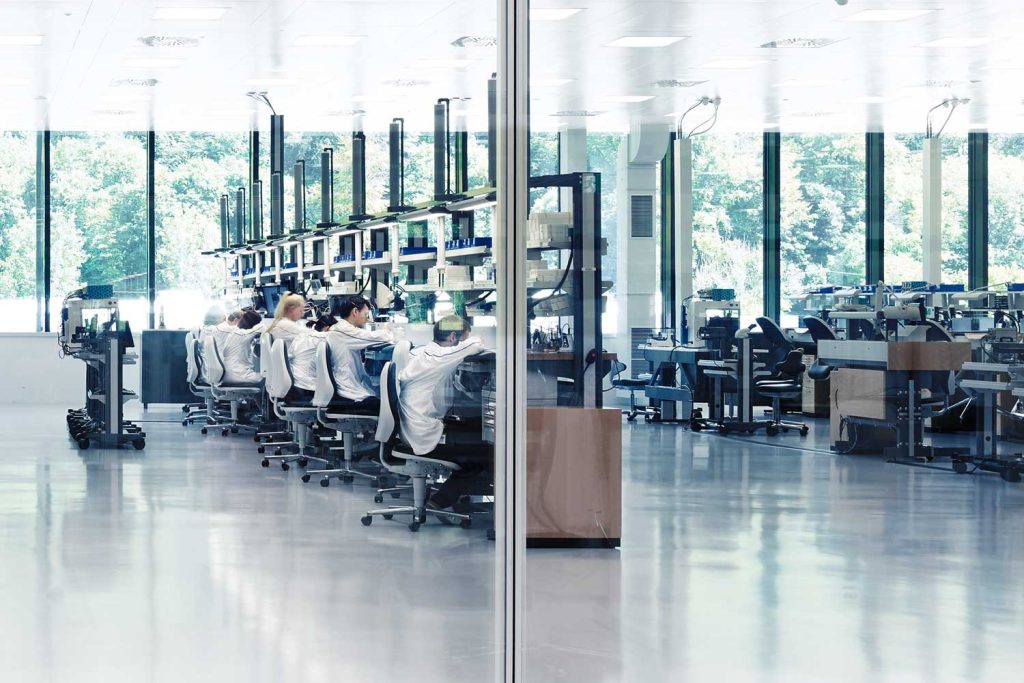
Movement assembly line
Will you be based here?
Well, I wish I was based somewhere. [Laughs] With as much as I travel, I sometimes feel I’m not based in any one particular place, but I come here once or twice a week with the team just to walk around, talk to people, and look at every aspect of the building to see if we can improve anything. We know the next phase is to fully digitalise the building so we can be in touch with everyone around the globe. My dream is to be able to have direct-broadcast question-and-answer sessions with people in any country in the world. And we are working on all this.
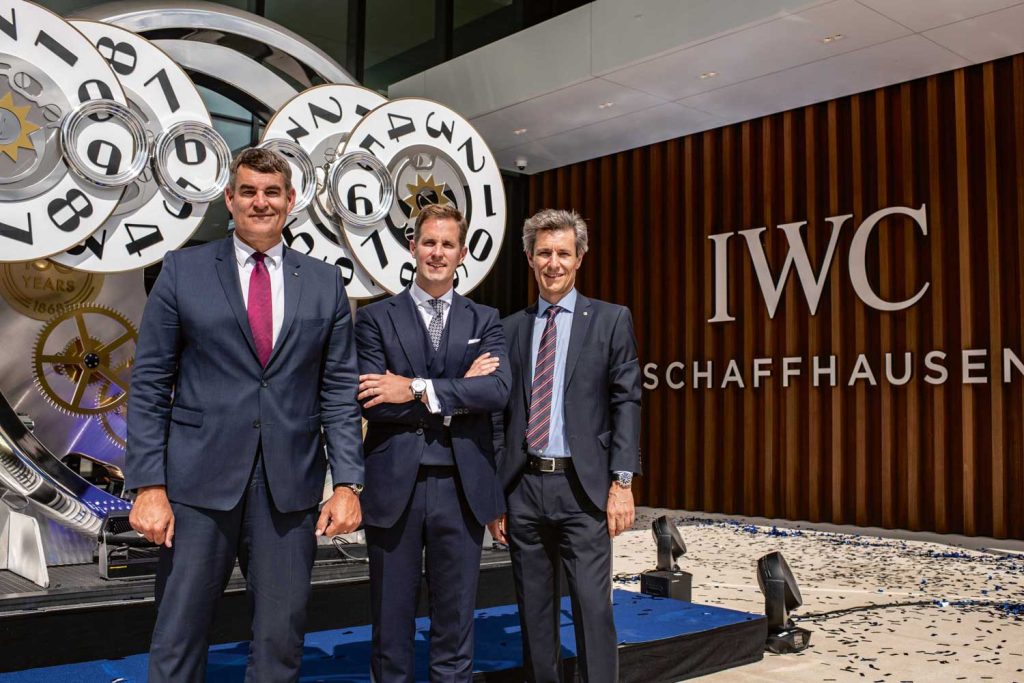
Mayor of Schaffhausen Peter Neukomm, and district president Christian Amsler, with Christoph Grainger-Herr at the inauguration of the new manufacture
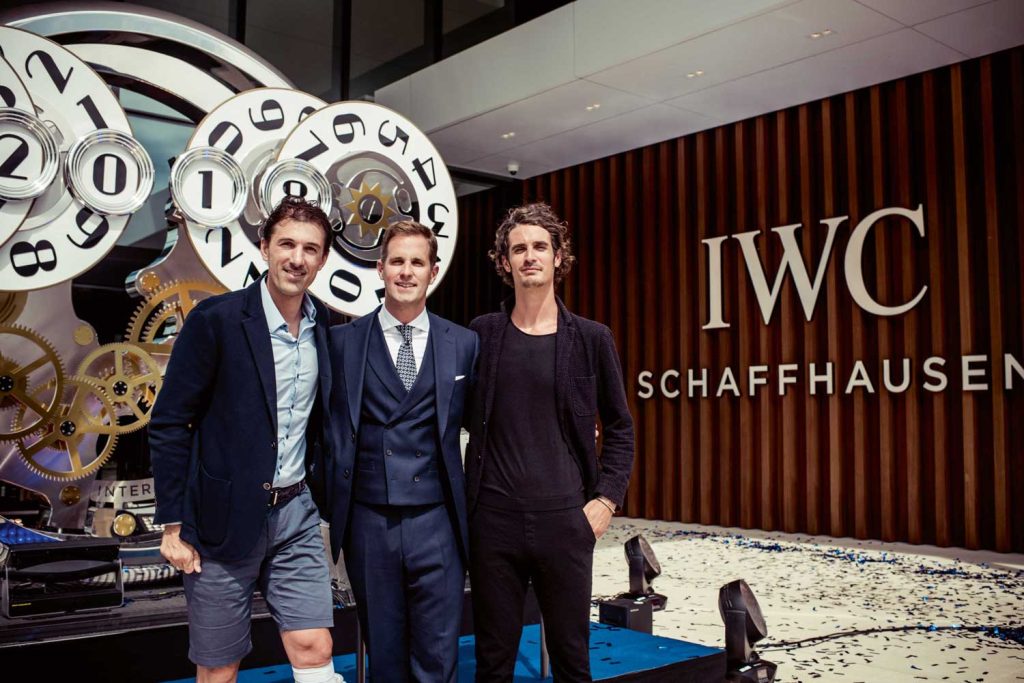
Brand ambassadors Fabian Cancellara and Patrick Seabase with Grainger-Herr
What’s the role of the original building today?
Well, you must understand that the original building dates back to 1874 and we’ve extended it 19 and a half times. It’s been through two World Wars and all of seven technical revolutions. So it is anything but ideal as a manufacture. But it is iconic because it is where we were founded, and as such, will always be our spiritual home — it will always be the heart of IWC. In contrast, this new building is light years ahead, because it is a true modern space that was built to serve the needs of the modern watch manufacture in every conceivable way.
How do you balance technology with craftsmanship?
There are things in watchmaking where the human touch is the only thing that makes the difference. For example, when you look at how a design starts and how a model of the watch needs to be fitted onto the wrist so you have the full tactile experience, no computer can predict this accurately. Similarly, there are steps in production where we feel as if the human touch is the superior way to doing it. But if there is a step where we can get better precision and higher quality by taking advantage of technology, then we will look into that.
That is why we show the technology in this manufacture so openly — it is our belief that technology and human hand can exist in such a way that they bring about a superior result. Remember that IWC was founded by Florentine Ariosto Jones with the desire to combine the best industrial approach with the best of Swiss handcraftsmanship, and this has always been our ethos.
What has the feedback from the watchmakers been?
You can see it on people’s faces. When you are working in your own department, it’s a different feeling from being in this connected space where everyone is talking to each other and working on the same project together. It’s a massive step forward in the working environment. Watchmakers can be quite critical when it comes to workspace and ergonomics and so far, the feedback has been very, very good.
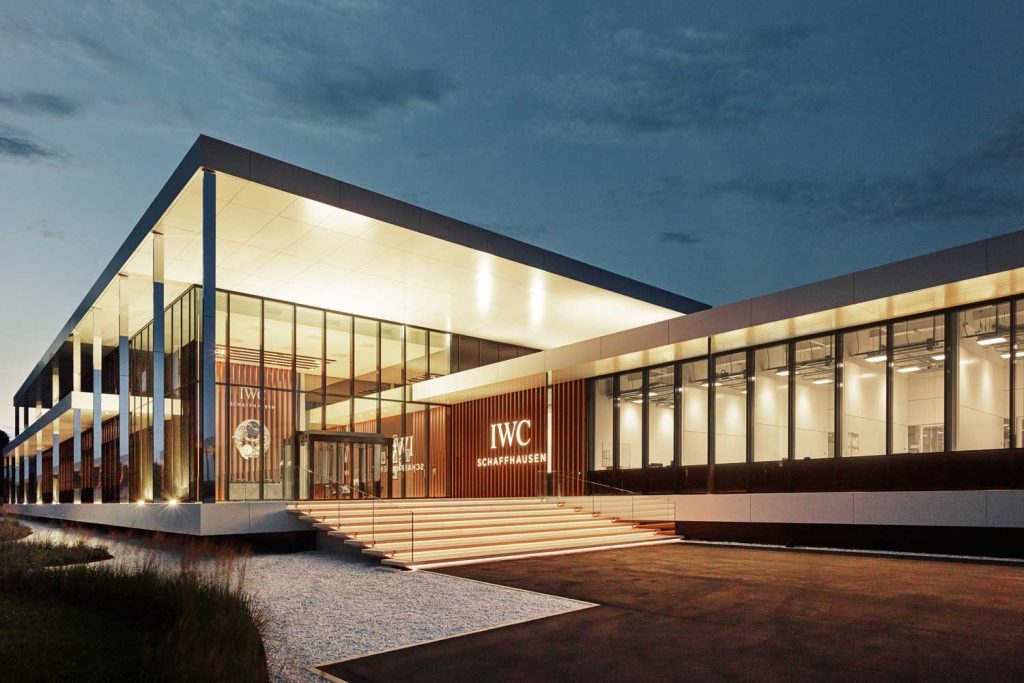
The manufacture by night
How important is it for end clients to come here?
You fall in love with a brand because of the design and the story. But when you visit its manufacture, you can see the love, the passion, the dedication that goes into the creation of each and every IWC watch.
How important are not just new watches but the watches you’ve sold in the past?
One of the key steps was the opening of the Heritage department, so that we can service and restore any IWC since 1868. I think that to truly call yourself a real manufacture and an authentic luxury watch brand, you need to take the steps to safeguard and preserve every watch that has ever left your factory. Part of this is also the ability to authenticate the watches and return them to the customer, with both an extract from the archive and a warranty for reliability after they’ve been serviced.
As an industry, we are always communicating the message that mechanical watches should last more than a single lifetime and be passed from one generation to the next. As such it is our responsibility to ensure that is possible. We make every effort to service watches from every era. IWC watchmaker Kurt Klaus or our museum curator David Seyffer also travel around the world with special museum pieces to tell the stories related to our brand.
You were the first Richemont Group brand and arguably the first luxury watch brand on E-Commerce. What’s was the objective?
We looked at this from a customer perspective, and decided that we needed to use all the different channels available and offer as many brand touchpoints as possible. In the past, there were only two or three distribution channels. Today there are many more and the number is constantly growing. Our job is to make each experience for the customer the best possible. I want our clients to be able to interact with us and buy from us anywhere, in any way and any time they like.
It is not as simple as people experiencing a brand online, then instantly clicking and buying a watch. It is also not like fashion: people don’t order eight watches to try on, expecting to return seven of them. And whether the final decision to purchase happens after a four-hour dialogue at a multi-brand retailer, or sat on a plane looking at the website on your mobile phone online, I don’t mind. It is the clients who will decide that. For me, it’s about creating an infrastructure that offers customers as much choice as possible.
How have the results been?
So far, our E-Commerce activities have been very successful, and I believe that our online presence complements our offline presence. The hardest thing to calculate is the attribution model for this, determining for example how many offline purchases were influenced by multiple online experiences and vice versa. However, we do know that offering more channels has a positive effect on the business as a whole.
You were always perceived as a very masculine brand do you feel this limits you in terms of women’s watches?
That perception depends on the market. Throughout our 150 years history, we have always offered ladies’ models, except for a period of around three or four years, which I would say is a relatively small window. Ladies’ watches are a natural part of the market and a growing segment of our business.
Do women buy more of your men’s watches or your women’s watches?
It’s two different markets. Some women prefer to wear an oversized man’s watch, while others opt for smaller, jewellery and even quartz watches. It is a little difficult for us to be able to track the percentage of men’s watches that are bought and worn by women, but we are happy to let customers choose whichever style they like.

Portofino showcased with female model on IWC’s e-commerce website
How do you engage the next generation of IWC enthusiasts?
Luckily our customer base has always been relatively young. We are a brand that the younger generation will consider to be their first milestone watch in their career, and that has been pretty stable over the last few years. What is evolving is the way that we tell our story through the various media channels now available. Back in 2006, the video for our Pilot’s Watch launch movie was 11 minutes long, and it was a DVD sent out by post. Clearly things are different today, and that’s why we need to keep innovating on the communication front to stay relevant. The good news is that the younger generation remains very interested in the brand. At SIHH this year, a whole group of 8-12 year olds were looking at the 150-year-old pocket watches that Kurt Klaus and his team had refurbished at the Heritage Centre, and they were absolutely fascinated.
What is the importance of brand ambassadors?
Luxury goods have always been associated with aspirational lifestyles. This has always been a part of the nature of the industry. Regarding IWC, what I deem important is that we have ambassadors who are genuinely interested in the brand. For example, Bradley Cooper had been wearing the IWC Big Pilot for several years before becoming our brand ambassador.
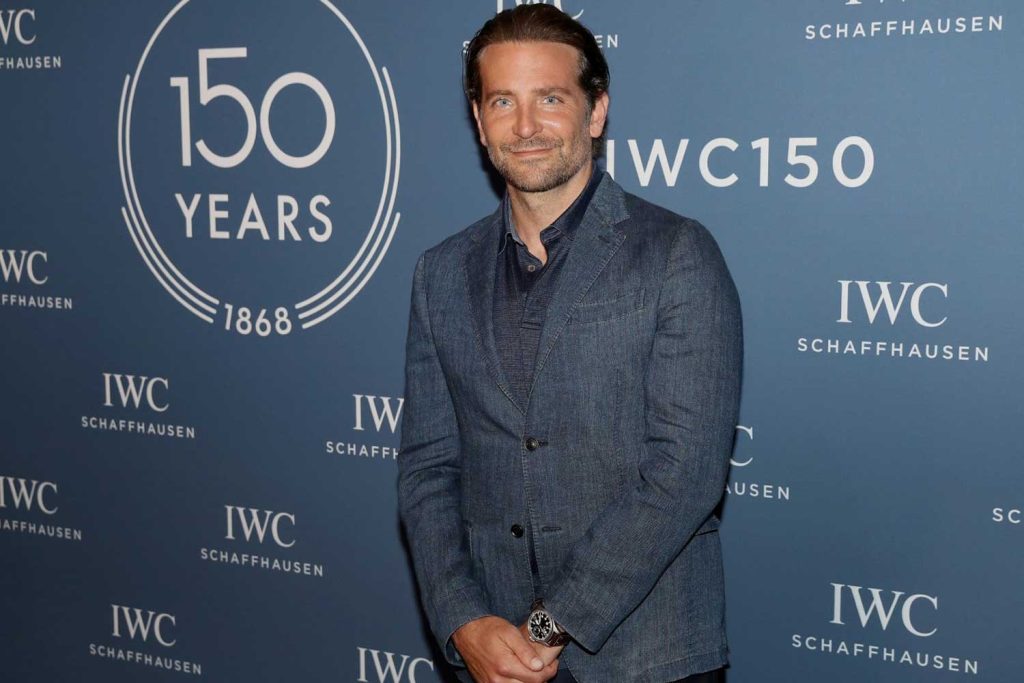
Bradley Cooper announced as IWC brand ambassador at SIHH 2018
Do you feel unnerved by the success of the Apple watch?
Smart watches have not been an issue. We are fundamentally two different categories. One product needs frequent updates and that does not offer much in terms of self-expression. And on the other hand, you have a mechanical microcomputer that is also a work of art and highly symbolic in value. Traditional watches have a totally different purchase motivation to smart watches which are more like wearable devices. I went to a conference with various Silicon Valley industry chief executives and they were all wearing high end mechanical watches – including quite a few IWC timepieces, I am very pleased to say!
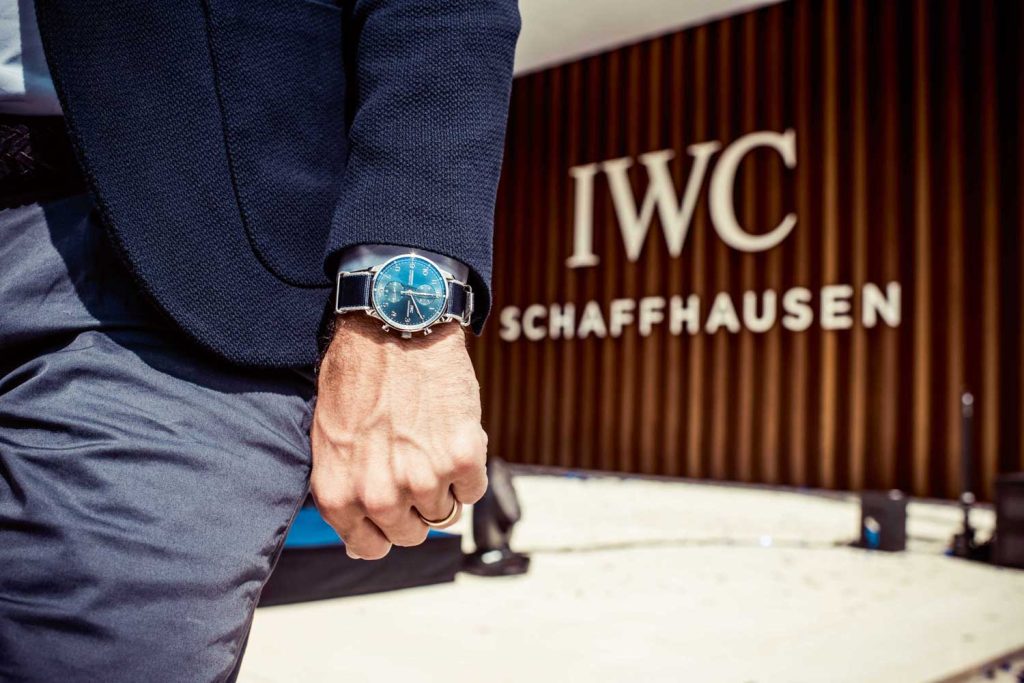
IWC










